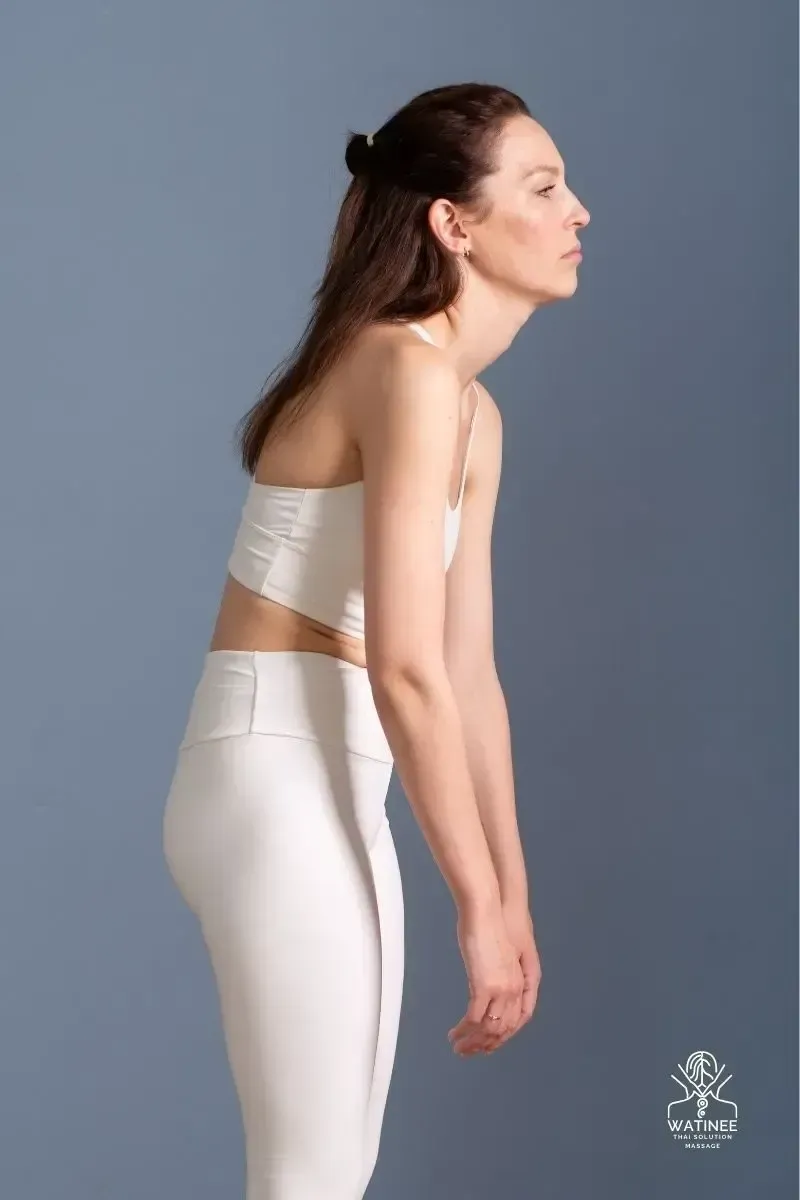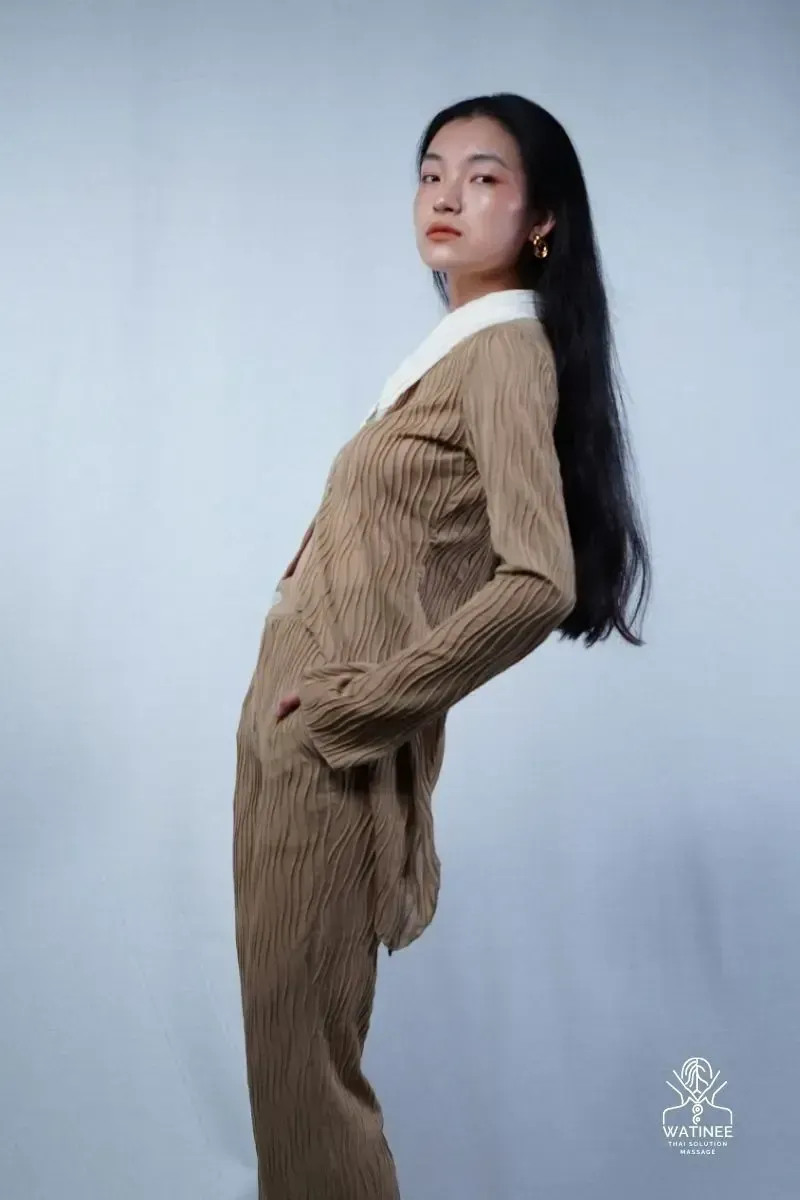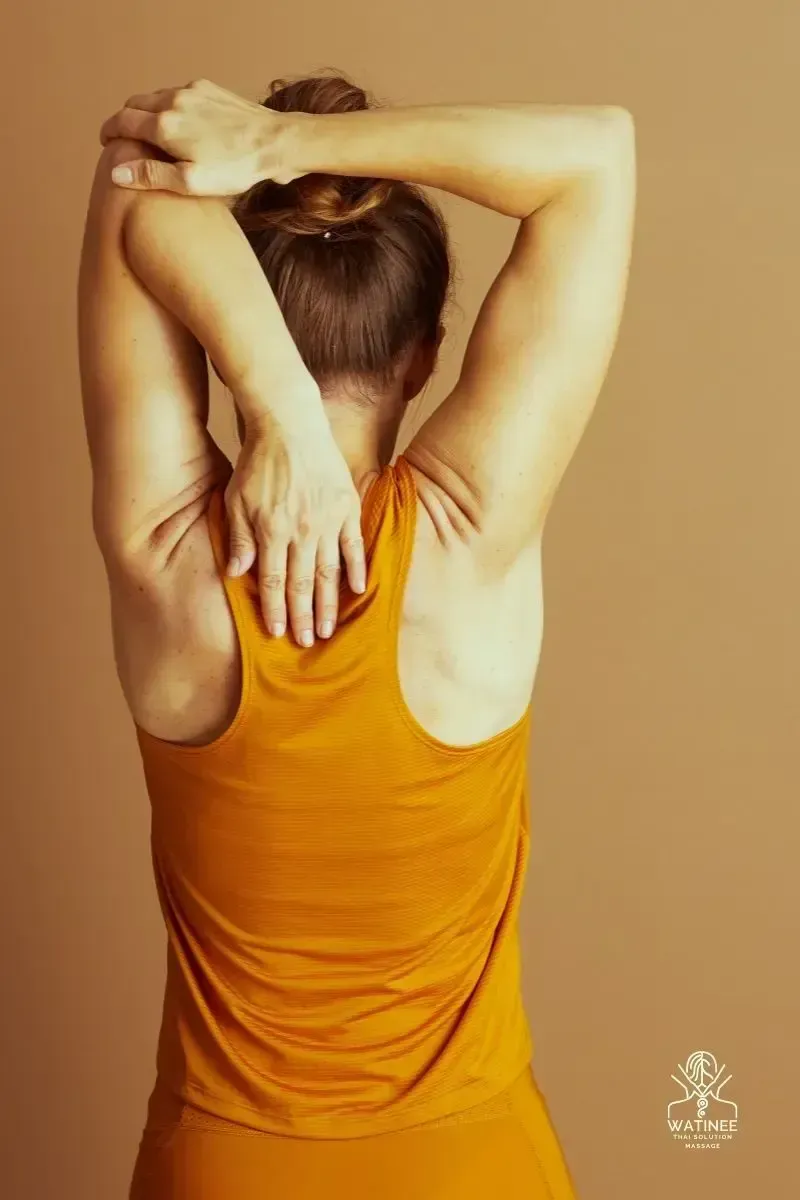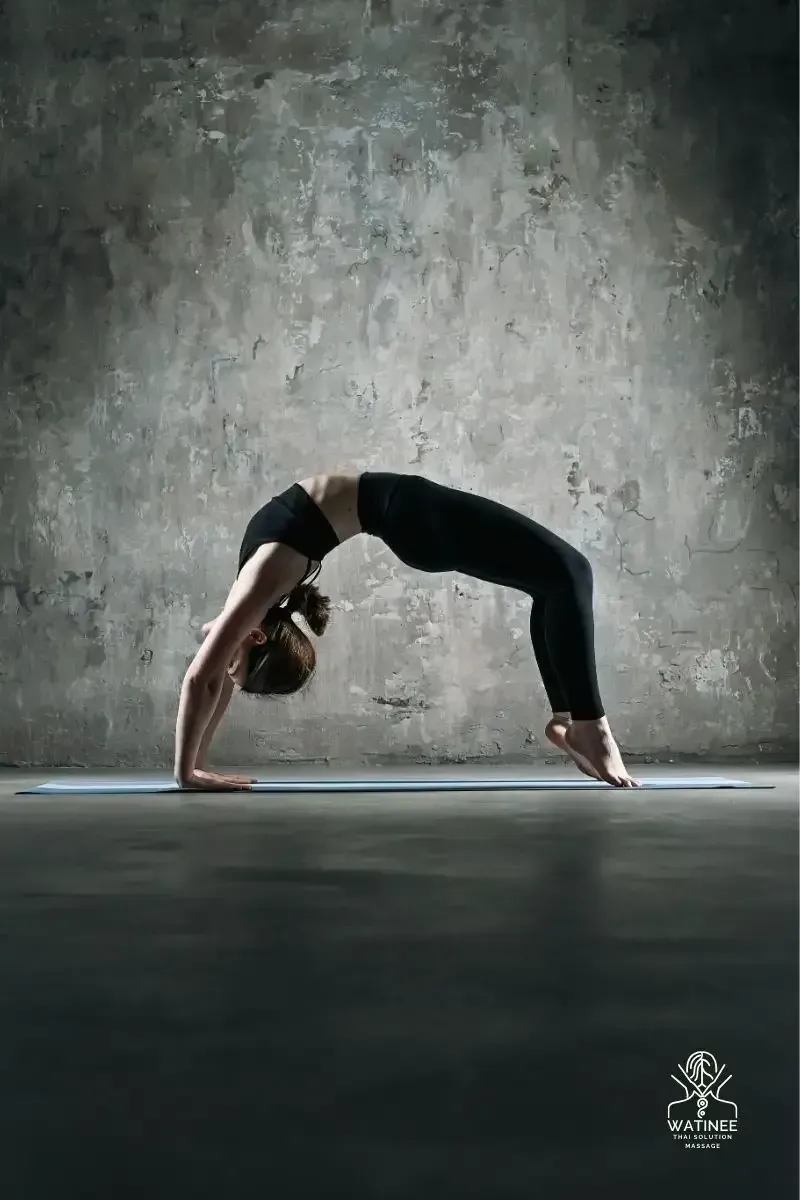WATINEE
Thai Solution Massage
Authentic Thai Therapeutic Massage in Downtown Bayonne
21 Rue Poissonnerie,
2nd Floor,
64100 Bayonne
(+33) 07 66 26 14 25
(fr/en/th)
Book your therapeutic experience now!
WATINEE
Thai Solution Massage
Authentic Thai Therapeutic Massage in Downtown Bayonne
21 Rue Poissonnerie,
2nd floor,
64100 Bayonne
Book your therapeutic experience now!
(+33) 07 66 26 14 25
(fr/en/th)
Chronic Back Pain: Understanding the Body and Restoring Balance Through a 4-System Approach
Massage Bayonne – Chronic Back Pain
Understanding the Pain Cycle and the 4-Step Care Sequence
Key insight :
Chronic back pain rarely comes from a single spot. It is the result of a “chain reaction” involving tendons and muscles, fascia, key pressure/reflex points, and the balance of joints. Recovery is most effective when done in a step-by-step order, allowing the body to gradually unlock and repair itself.
What is Chronic Back Pain?
Back pain that persists or keeps coming back for more than 3 months, or that recurs after heavy use, long sitting, stress, or even rest without improvement, is considered chronic. It is often accompanied by stiffness, limited flexibility, mild weakness, or pain radiating down into the hip and leg.

Fig. 1: Massage Bayonne – 4-system recovery for chronic back pain balance
Main Causes: Why the Body Hurts and Becomes Imbalanced
Repetitive use and poor posture: sitting too long, standing unevenly, lifting incorrectly, or moving with poor walking/running form.
Weak or imbalanced muscles: some muscle groups overwork while others stay underactive.
Fascia restrictions and poor circulation: superficial and deep tissues don’t glide smoothly over each other.
Nervous system sensitization: pain signals are triggered more easily, even by minor stimuli.
Stress and lack of sleep: stress hormones keep muscles tense and slow down repair.
Poor posture and shallow breathing: the diaphragm underperforms, body pressure is unbalanced, and this affects the spine and pelvis.
The Pain Cycle That Makes It Chronic (Chain Reaction)
1. Pain → Protective tension: muscles around the back and hips tighten as a defense.
2. Prolonged tension → Fascia buildup: circulation decreases, tissues stick, and movement worsens.
3. Tight fascia → Nervous system hypersensitivity: pain spreads or tingling appears easily, even from distant points.
4. Reduced movement → Bone imbalance: pelvis and spine lose alignment, causing pain to return.
In short: if we only treat the “spot of pain” but let the whole cycle spin on, the discomfort inevitably comes back.
Common Misconceptions

Fig. 2 : Massage Bayonne – Illustration of slouched posture representing common misconceptions about chronic back pain
Strong pressure is needed to heal → Inflamed tissues get more irritated, increasing the risk of recurring pain.
Rest alone is enough → Lack of movement leads to stiffness and weakness, making pain return.
Press exactly where it hurts and it’s solved → The pain cycle follows connected pathways; multiple systems must be unlocked.
Results must be immediate → The body repairs step by step, requiring time and consistency.
A normal X-ray or MRI means nothing is wrong → The issue may be functional, not visible on scans.
If Not Managed in the Right Order, It May Progress to…

Fig. 3 : Massage Bayonne – Example of arched posture showing how untreated back imbalance can progress
Chronic nerve irritation: shooting pain or numbness down the leg (sciatica).
Overloaded spinal joints: facet syndrome, pain when bending backward or twisting.
SI joint/pelvic imbalance: pain in the buttocks, hips, or groin.
Lower chain issues: Achilles tendon problems, plantar fasciitis, knee stiffness from back-related tension.
Upper chain compensation: tight neck and shoulders, muscle-related headaches.
Sleep and mood problems: light sleep, fatigue, reduced focus.
The 4-System Care
Principle of Recovery: Working in a 4-System Sequence
Tendon and muscle system – release tension and restore balanced activity.
2. Fascia system – bring back tissue fluidity.
3. Energy point system – adjust reflexes and nerve signals from key linked points.
4. Bone balance system – align pelvis and spine so they carry loads correctly.
👉 Following this sequence helps the body respond better because it “unlocks the outer layers before the deeper ones.”

Fig. 4 : Massage Bayonne – Pelvic imbalance and spinal stress
System 1: Tendons and Muscles – Unlocking the First Layer
When back pain strikes, the body switches into “alert mode.” The tendons and muscles around the spine tighten instantly, like a rope pulled tight to prevent further injury. But if this continues too long, the rope itself causes even more pain.
What the body is doing
Some muscles overwork
Muscles in the lower back, waist, and hips stay constantly tense, like a rope that never slackens. This creates deep pain and fatigue.
Opposite muscles underwork
Muscles meant to support—such as deep abdominals or side glutes—stay “lazy.” As a result, the body relies too much on the already tight muscles.
Tendons and anchor points are strained
Daily pulling irritates the spots where muscles attach to bones, like an elastic band stretched too often.
👉 Releasing the tendons is like “loosening the big rope.” Once it softens, the tight muscles relax as well. A second release of the muscles helps prevent them from tightening again too quickly.
👉 Effects you can notice
Warmth and improved blood flow, greater bending and reaching range, less sharp pain, easier sitting and standing.
A lighter feeling overall, easier breathing, and the ability to straighten up with less effort.
System 2: Fascia – Releasing to Make the Body Smooth Again
Fascia can be thought of as a “clear film” wrapping around the muscles. When we sit too long without moving, this film crumples and tightens. Every movement then feels stiff and painful, as if wearing clothes that get tighter and tighter.
What the body is doing
Fascia is a thin layer that surrounds and connects all muscles. When the body stays tense too long, fascia contracts and loses its natural glide.
Instead of muscles sliding smoothly over one another, they stick and rub, causing stiffness along entire lines of movement.
Tension can start at the feet, travel up through the calves and thighs, reach the pelvis, and end up in the back—like a rope pulling from bottom to top.
👉 By releasing the fascia, the body regains its “smooth glide.” Bending, stretching, or twisting feels lighter and easier.
👉 Effects you can notice
Tissues glide more freely, stiffness spreads less, movements feel softer.
Where bending once caught or stuck, you can now move through smoothly.
System 3: Energy Points – Resetting the Pain Signals
Once tendons, muscles, and fascia are released, it’s time to “switch off the alarm.” Key points on the back and shoulder blades act like control buttons. When pressed at the right place, with the right timing and pressure, they reset the system and bring calm.
👉 Drawing on Thai–Chinese energy line concepts alongside nerve reflex explanations.
What the body is doing
On the back and shoulder blades are “key points” that, if too tight, send pain signals down to the lower back, fueling chronic pain.
There are also distant points — under the feet, behind the knees, or at the neck — yet they connect along the same chains. When these are tight, they can trigger or worsen low back pain.
👉 These points should only be pressed once the body is already released. If pressed while everything is still tight, pain increases and the body tenses even more.
👉 Effects you can notice
A warm, relaxed feeling; yawns or deep sighs (signs of the parasympathetic system kicking in); reduced radiating pain.
Many people feel their back lighten immediately, as if a weight was lifted off.
System 4: Bone and Joint Balance – The Body Adjusts Itself
Many people believe they need their bones to be “cracked” to feel better. In truth, if the first three steps are done well, the body often realigns the pelvis and spine on its own through everyday movement — walking, doing housework, or gentle exercise.
What the body is doing
The pelvis may tilt or rotate slightly, putting extra stress on certain parts of the spine.
If muscles and fascia remain tight, even after correction, the body quickly gets pulled back out of balance.
👉 But once tendons loosen, muscles relax, fascia stops constricting, and pain signals calm down, the bones naturally settle back — like a puzzle piece slipping into its proper place.
👉 Effects you can notice
Weight carried more evenly left to right, longer steps, fewer joint noises, slower recurrence of pain.
Standing taller, walking with better balance, and less frequent flare-ups.
Self-Care Basics (Safe and Practical)
10-Minute Daily Routine

Fig. 5 : Massage Bayonne – Simple exercises to relieve chronic back pain
Simple exercises anyone can do:
1. Cat–Cow stretch: 1 minute
2. Hamstring stretch (gently bending forward to touch toes): 1 minute
3. Shoulder and shoulder blade rotations in big circles: 1 minute
4. Hip stretch (Lunge Stretch): 1 minute per side
5. Seated twist on a chair: 1 minute per side
6. Lying on your back, pulling knees to chest: 1 minute
7. Deep breathing with hands on the belly: 2 minutes
Ainsi, le corps recrée naturellement une couche protectrice gélatineuse autour du nerf, réduisant sa sensibilité.
Small lifestyle adjustments
Change posture every 30–45 minutes.
Use a small lumbar cushion during long sitting sessions.
Sleep on your side with a pillow between the knees, or on your back with a pillow under the knees.
Warning signs to see a doctor immediately
Numbness or weakness spreading in both legs, loss of bladder or bowel control, fever with back pain, severe pain after an accident, unexplained weight loss.
Conclusion

Fig. 6 : Massage Bayonne – Conclusion on the 4-system approach to relieve chronic back pain
Chronic back pain involves the whole body system, not just one spot. Care that gradually follows the 4-step sequence — tendons and muscles → fascia → energy/reflex points → bone balance — helps the body restore its natural ability to heal. The key is gentleness, consistency, and time, combined with small daily adjustments.
This content is for general informational purposes only and is not medical advice. It is not intended to diagnose, treat, or guarantee any outcome. If you experience severe or unusual symptoms, please consult a doctor or qualified healthcare professional.
Local Information:
Our massage center is ideally located in the heart of Bayonne, in the beautiful Basque Country—just 15 minutes from Biarritz.
Address : 21Rue Poissonnerie, 2nd floor, 64100 Bayonne, France
Phone : (+33) 07 66 26 14 25

For reviews and more details about our massage Bayonne services, visit our Google Business Profile.
Discover the must-do activities in Bayonne to extend your massage Bayonne experience
A perfect place for a relaxing walk before or after your session
Découvrez ça
IMPORTANT : Visits by appointment only
To ensure personalized attention and the availability of our expert, please call us in advance to schedule your session
Booking:
(+33) 07 66 26 14 25
(fr/en/th)
Opening hours:
Mon-Fri : 10h-19h
Sat-Sun : 10h-12h30
Addresse:
21 Rue Poissonnerie, 2nd floor, 64100 Bayonne, FR
Email:
info@watinee-thaisolutionmassage.com
© 2025 Watinee Thai Solution Massage. All rights reserved.
Opening hours:
Mon-Fri : 10h-19h
Sat-Sun : 9h30-12h30
Addresse:
21 Rue Poissonnerie, 2nd floor, 64100 Bayonne, FR
Booking:
(+33) 07 66 26 14 25
(fr/en/th)
Email:
info@watinee-thaisolutionmassage.com
© 2025 Watinee Thai Solution Massage. All rights reserved.






